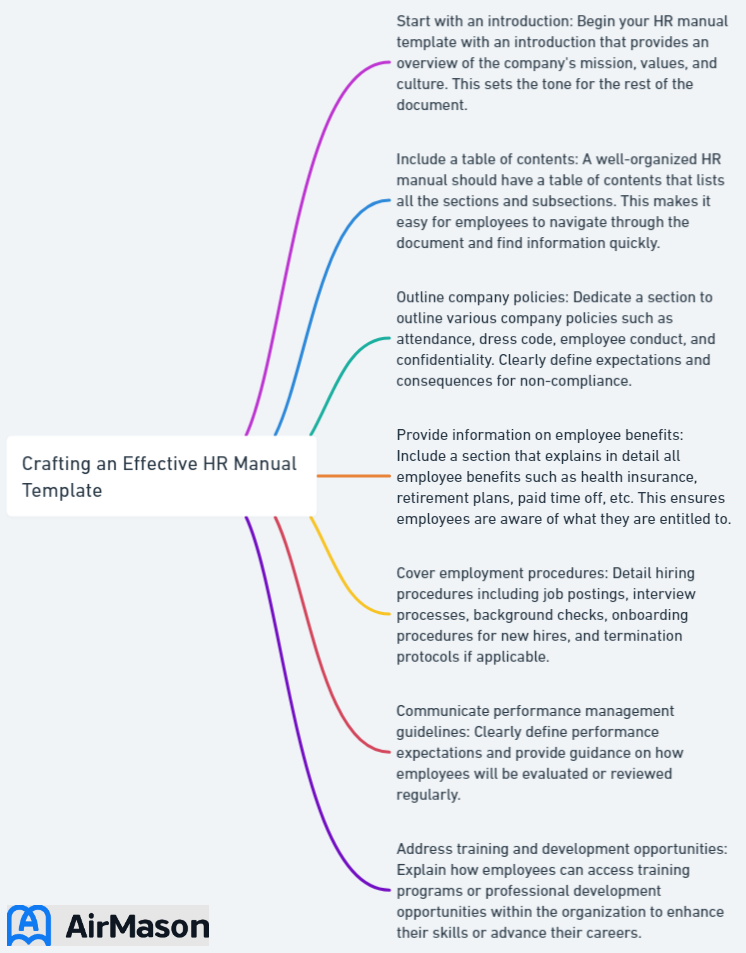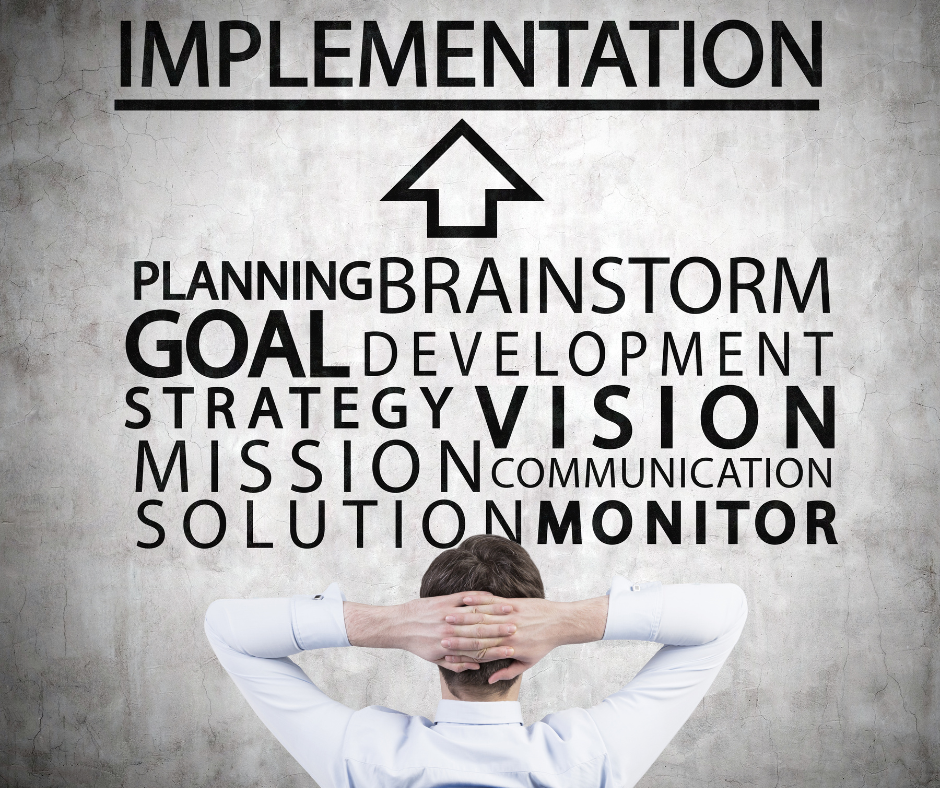
Crafting an effective HR manual template is crucial for any organization striving for success. A well-designed manual serves as the cornerstone of effective HR management, compliance, and fostering a positive work culture. Dive into this comprehensive guide to learn how to create an HR manual that not only addresses the legal aspects but also resonates with your company’s unique values and goals.
Key Takeaways
- Creating an effective HR manual template requires assessing company requirements and evaluating various formats.
- Customizing the template to reflect a company’s culture, update policies & procedures, and ensure legal compliance is essential for success.
- Regularly updating the HR manual with comprehensive training resources encourages employee understanding & compliance.
Why You Need an HR Manual Template
The successful management of an organization’s human resources greatly relies on a well-structured HR manual template, otherwise known as an employee manual. An efficient HR manual template can facilitate human resources management, guarantee legal adherence, and encourage a healthy work environment. Adherence to regulations requires documentation of internal and company policies, including those regarding:
- the use of company property
- employee conduct and behavior
- leave and time-off policies
- performance evaluations and feedback
- disciplinary procedures
- employee benefits and compensation
Having a comprehensive HR manual in place ensures that employees are aware of the company’s policies and procedures, and helps maintain consistency and fairness in the workplace.
Utilizing templates, such as a procedures manual template, can facilitate the process of creating an employee handbook, thereby saving time, money, and ensuring the handbook is compliant with current employment policies. By using a customizable online service or an employee handbook template, you ensure your company’s policies and procedures are up to date and legally compliant, allowing employees to clearly understand their rights and obligations.

Choosing the Right HR Manual Template
In order to effectively inform employees about the company’s policies and procedures, the right HR manual template must be selected. It is important to assess your business requirements and evaluate templates that are tailored to the industry and size of the company, such as the SHRM Employee Handbook Builder.
HR manual templates are available in various formats, including Microsoft Word, Apple Pages, and PDF, which can help organizations effectively manage and reward employees. Each format has its advantages and disadvantages. PDF is a secure format compatible with all devices. However, it can be more challenging to edit. Apple Pages is excellent for creating attractive documents; however, it may not be compatible with all devices.
Ultimately, choosing the right format depends on your organization’s needs and preferences, ensuring the template effectively communicates essential information to your employees.
Customizing Your HR Manual Template

To maintain a legal and compliant framework, customizing an HR manual template becomes a necessity. It ensures that the regulations of each federal and state laws, including the Family Medical Leave Act, industry-specific regulations, and values of the company culture are followed.
In the following sections, we will discuss how to adapt your HR manual template to reflect your company’s unique culture, update policies and procedures, and ensure legal compliance.
Adapting to Company Culture
For your HR manual policies to align with your company culture and values, tailoring becomes necessary. To accurately reflect your company’s unique culture and values, incorporate language that encapsulates the company’s mission, values, and goals. Furthermore, policies should be customized to the company’s particular needs and expectations, such as dress code, anti-harassment, and workplace policies.
Examples of how to tailor policies and procedures to the company’s specific needs include providing real-world scenarios that employees can identify with and showcasing how the policies and procedures are used in various contexts. When employees observe concrete examples, they can comprehend how to apply them in their own work, making the policies more tangible and easier to recall.
Updating Policies and Procedures
To ensure compliance and effectiveness, it’s vital to keep your HR manual updated with the latest policies, procedures, and regulations. To update policies and procedures, establish a team that includes representatives from HR, legal, and other departments, as well as other stakeholders who could be impacted by the modifications.
When revising policies and procedures, it is essential to consider the existing policy, relevant laws or regulations, and any organizational modifications that may have taken place. Draft new policies in a clear and concise manner, ensuring that all necessary information, such as definitions, procedures, and consequences, is included.
Communicate the policy revision to employees expeditiously, including any associated training or education, and detail any alterations to the policy and the rationale for those changes.
Ensuring Legal Compliance
Mitigating potential liabilities and promoting organizational success necessitates legal compliance in an HR manual. It is important to ensure legal compliance in an HR manual. To achieve this, customize the template to incorporate federal and state laws, industry-specific regulations and company culture..
Consulting with legal and HR professionals is crucial to guarantee that all policies conform to employment laws and regulations. In the next section, we will discuss the importance of consulting these professionals and how they can help in developing an effective HR manual.
CalHR HR Manual
The CalHR HR manual serves as a comprehensive guide for the California Department of Human Resources (CalHR) and its personnel. This invaluable resource offers detailed information and guidelines pertaining to various aspects of human resources management within the state government. The CalHR HR manual covers essential topics such as recruitment and hiring processes, employee classifications, benefits administration, performance evaluations, and disciplinary procedures. It provides a standardized framework to ensure consistent and efficient HR practices across state agencies, facilitating effective workforce management and adherence to regulatory requirements. Access to the CalHR HR manual equips HR professionals with the knowledge and tools necessary to navigate the intricacies of personnel management and contribute to the overall success and productivity of the California state workforce.
Key Components of an HR Manual Template

An HR manual template is utilized to furnish employees with a comprehensive understanding of the organization’s regulations, processes, and expectations. The key elements of an HR manual template encompass employment policies, employee benefits, and performance management.
In the following sections, we will delve deeper into each component, exploring how they guarantee that employees are cognizant of the organization’s policies and procedures, as well as their rights and obligations.
Employment Policies and Procedures
Ensuring consistency and fairness within an organization requires a comprehensive overview of employment policies and procedures. Utilizing tools like SHRM’s free sample template or premium, customizable online services can help you create an employee handbook tailored to your organization’s requirements.
The employment policies and procedures section of an HR manual should be comprehensive. It should include:
- Onboarding processes
- Company information
- Policies and culture
- Legal requirements
- Time off policies
- Benefits
- Promotion and compensation
- Discipline and termination policies
By creating a detailed and customized employee handbook, you provide a solid foundation for your employees to understand their rights, responsibilities, and the expectations of the organization. Employee handbooks also serve as a valuable resource for both new and existing employees, ensuring everyone is on the same page regarding company policies and procedures.
Employee Benefits and Perks
To attract and retain top talent within your organization, a detailed outline of employee benefits and perks is crucial. Customizing the benefits and perks section of your HR manual to fit your company’s specific offerings ensures employees are aware of the full range of benefits available to them.
The employee benefits and perks section of an HR manual template should include health insurance, employee code of conduct, and pertinent legal information. By providing comprehensive information on benefits and perks, you demonstrate the value your organization places on employee well-being and satisfaction.
Performance Management and Reviews
Supporting employee growth and success within an organization requires a structured approach to performance management and reviews. Performance review templates can be customized for your organization and incorporated into your HR manual to ensure a consistent and well-defined process for evaluating employee performance.
The Performance Reviews section of your HR manual should include details on:
- The performance review process
- Feedback
- Promotions
- Salary increases
- Bonuses
By implementing a clear and consistent performance management system, you encourage employees to strive for continuous improvement and professional growth.
Templates for Training Manuals
Templates for training manuals are essential tools that provide a structured framework for creating comprehensive training materials. These templates are designed to streamline the process of developing training manuals by offering predefined sections, formatting guidelines, and layout designs. They help ensure consistency in content presentation and enable trainers to focus on the specific content relevant to the training objectives. Utilizing templates for training manuals not only enhances efficiency but also helps maintain a professional and cohesive look throughout the manual. These templates often include placeholders for important details such as course objectives, instructional methods, assessment criteria, and other crucial components, making it easier for trainers to organize and present information in a clear and logical manner. In summary, templates for training manuals are invaluable resources that facilitate the efficient creation of effective training materials.
Utilizing Visuals and Examples

Incorporating visuals and examples into your HR manual can significantly enhance engagement and facilitate understanding. Visuals, such as:
- Infographics
- Charts
- Videos
- Text-based visuals
can simplify complex concepts, summarize information, visualize data and statistics, and aid in organizing information. Additionally, they can be used to explain procedures or demonstrate proper techniques, thereby enhancing understanding and engagement of employees with the HR manual.
Examples can facilitate comprehension of HR policies and procedures by providing real-world scenarios that employees can identify with. When employees observe concrete examples of how the policies and procedures are used in various contexts, they can comprehend how to apply them in their own work, making the policies more tangible and easier to recall.
Making Your HR Manual Accessible

Promoting understanding and compliance necessitates making your HR manual accessible to all employees. Online platforms that can host digital HR manuals include:
- ClickUp
- Blissbook
- Handbooks.io
- ProProfs
- AirMason
These platforms allow employees to access the information easily and securely.
In addition to providing a digital version, consider offering your HR manual in multiple languages and printable formats to cater to the diverse needs of your workforce. By making your HR manual accessible to all employees, you foster an inclusive work environment and demonstrate your organization’s commitment to employee well-being.
Regularly Updating Your HR Manual
Staying current with changes in laws, regulations, and company policies requires regular updates to your HR manual. To keep your HR manual up-to-date, employ best practices, such as conducting audits, reviewing content, and setting a schedule for updates.
It is recommended to review and revise your HR manual at least once a year to ensure compliance with the latest laws, regulations, and company policies. However, more frequent updates may be necessary if there are noteworthy changes in the legal or regulatory environment or if there are modifications in company policies or procedures.
Consulting with Legal and HR Professionals

To ensure all policies conform to employment laws and regulations, consulting with legal and HR professionals is necessary. These professionals can provide expertise and knowledge in HR policies and practices, including:
- Ensuring compliance with legal requirements and regulations
- Incorporating industry best practices and benchmarks
- Customizing the manual to the organization’s specific needs and culture
- Enhancing the clarity and effectiveness of the manual’s content
By consulting with these professionals, you can ensure that your HR policies are comprehensive, up-to-date, and in line with legal and regulatory standards.
By collaborating with HR professionals in developing an effective HR manual, you ensure your organization is not only legally compliant but also fosters a positive work environment that supports employee growth and success.
Implementing the HR Manual in Your Organization

To guarantee proficient human resources management, adherence to the law, and congruence with company goals and objectives, implementation of the HR manual within an organization is necessary. Providing comprehensive training resources for HR personnel and company management is crucial for the successful implementation of an HR manual.
Effective implementation also involves providing online resources and written materials that support employee understanding and compliance with the policies and procedures outlined in the HR manual. By offering various resources and engaging training, you ensure that employees fully comprehend the expectations and obligations set forth in the HR manual.
Organizational Manuals
Organizational manuals serve as comprehensive guides that outline the essential policies, procedures, and protocols within a specific organization. These manuals are meticulously designed to provide a structured and standardized framework for employees to follow, ensuring consistency and clarity across the organization. The content within organizational manuals typically covers various aspects, including employee roles and responsibilities, operational guidelines, safety protocols, and adherence to organizational values and culture. By presenting a consolidated and easily accessible source of information, organizational manuals facilitate effective onboarding of new employees, aid in training and development, and assist in resolving conflicts or issues by providing clear guidelines for appropriate actions and decision-making. Moreover, these manuals often evolve to reflect organizational changes, regulatory updates, and advancements in industry best practices, ensuring that the organization remains adaptive and compliant in its operations.
Summary
Creating an effective HR manual is vital for any organization striving for success. By customizing your manual to reflect your company’s unique culture, updating policies and procedures regularly, ensuring legal compliance, and making it accessible to all employees, you lay the foundation for a thriving work environment. With a well-structured HR manual in place, you empower employees with the knowledge they need to succeed, fostering a positive and legally compliant workplace for all.
Frequently Asked Questions
How do I create a HR manual?
Create an HR manual by defining the audience, outlining organizational policies and procedures, including sections on emergencies and deaths, keeping content crisp and relevant, being positive, and avoiding repetition.
What should be included in an HR manual?
An HR manual should include policies and procedures, Americans with Disabilities Act information, Personal Safety rules, Sexual Harassment prevention, Drug and Alcohol policies, Violence and Weapons regulations, Attendance requirements, Hours of Work, Meal and Rest Periods, Recruiting and Hiring Policies, At-Will Employment, Conduct Policies, Employment Classification, Non-Discrimination and Anti-Harassment statements, Safety Policies, a Notice and Disclaimer / Acknowledgement of Receipt, Equal Opportunity Statement, Work Authorization, Policy on Employment Classification, Company Mission, Vision and Values, Code of Conduct, Dress Code, Communications Policy, Compensation and Benefits Information, Reviews, Promotions and Raises, PIP Plans.
Does Word have a handbook template?
Yes, Word does have a handbook template called the Employment Handbook Template, which provides companies with a professional-looking employee manual or handbook.
What is HRM manual?
A Human Resources Manual is a document outlining key processes, policies and expectations of an organization for its HR department, leadership and managers. It provides an accessible and consistent source of reference for all stakeholders.
What factors should be considered when choosing an HR manual template?
When choosing an HR manual template, it is important to consider company size, industry, and any specific HR needs in order to ensure the template fits your organization’s requirements.